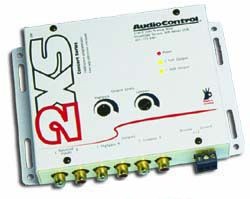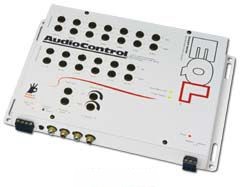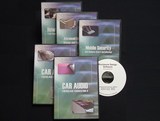Car Audio Signal Processors - Crossover, Equalizers and More
The function of equalizers, crossovers, and other signal processors is to electronically change the music signal in some way to make it more usable. These processors are sometimes built into other units such as amplifiers. However, they are at their absolute best when designed as an outboard unit.
Crossovers

The crossover's purpose is to divide the music signal by frequency and send these frequencies to components "downstream" of the crossover. For example, in a system with a two-way component set and a subwoofer the crossover would send the low frequencies to the subwoofer's amplifier and the high frequencies to the component speaker amplifier(s). Crossovers vary in their flexibility. Some only have a few frequencies to choose from while others have a whole range of frequencies to choose from. Also the rate at which the frequencies are attenuated (slope), measured in decibels per octave, can be adjusted on some units. A minimum standard for electronic crossover slopes is 12 db/octave while 18 db/octave is better and 24 db/octave is typically the highest you will find.
Equalizers


The equalizer is a sophisticated tone control for the system, adjusting many different low, mid and high frequencies. Equalizers come in many forms including dash and trunk mount units with either graphic, parametric, or quasi-parametric processing. The most common type of unit is the graphic, in-dash variety. Usually half the height (half-DIN) of a source unit, this type is the most easily adjustable and therefore the most often misused. An equalizer should really only be set once to overcome the acoustic problems of the car and then adjusted only periodically when tuning the system. This is why trunk mount units are used in car audio competition more often than the in-dash variety. When using an equalizer do not overdue the boost on a frequency. If possible try to cut a frequency rather than boosting another. Over-equalizing a system can cause damage to the components, especially the speakers.
Surround Sound and Other Processors
There are other signal processors that perform various tasks. Some extract information to be sent to a center channel speaker, some add various sound effects or echoes to the music while some can even change phasing and delay. One of the more popular signal processors is the bass restoration unit. The most well known unit is the AudioControl EPIC-160 and Epicenter. Many new units are becoming available that decode surround sound information on DVD and the new audio disc formats such as DVD-Audio and SuperCD. These units can be useful (and expensive) but they can also be frivolous (and expensive). There are very few low quality signal processors that perform these extra features. They are usually reserved for competition vehicles or for the owner that has/wants everything.
Features and terms relating to the various processors are as follows:
Bands: This is the number of frequencies an equalizer can adjust at one time.
Center Channel Output: An output that contains the musical information found in both the right and left channels. Some processors remove the common left/right information and send it to the center channel. Other processors simply extract the common information but leave it intact in the left/right channel.
Continuously Variable: This is a crossover's ability to be adjusted to a range of frequencies rather than a set of a few frequencies. Some units (notably AudioControl) have adjustable frequencies but they must be changed with an internal resistor pack. This is more accurate than the potentiometer and most variable controls but also a bigger hassle during installation and tuning
Curve (Equalizer): This is the way that the equalizer is set from frequency to frequency.
Decibel (dB): This is the measure of how loud a sound is based on a scale of zero decibels being the threshold of human hearing. Doubling the amplifier power gives an increase of three decibels while ten decibels is needed for a sound to be perceived as twice as loud.
Delay: The amount of time, usually in milliseconds (ms), that a signal processing unit adds to a channel of music. This is usually used to delay the rear channels with respect to the front channels to give a sense of greater space.
DSP: Standing for digital signal processing it is most commonly found in processing units to recreate or simulate a specific acoustic environment. Many older units used this technology to recreate venues like a concert hall or a disco club. Most newer units do not use DSP for this (the gimmick gets old quickly).
Graphic: This equalizer has only a set of fixed frequencies that can be adjusted. Most often found on in-dash units.
Octave: Refers to the distance between two frequencies. One octave is twice the reference frequency. For example, 200 Hz is one octave away from 100 Hz. 400 Hz is one octave away from 200 Hz and two octaves away from 100 Hz.
Parametric: This type of equalizer has the ability to have the frequencies of adjustment varied as opposed to a graphic equalizer with fixed frequencies. It also allows the Q adjustment of the frequency controls. (Q is defined below)
Phasing: Refers to how far a signal varies, in degrees, from another signal. For example, if two subwoofers are wired with their terminals (+ and -) reversed with respect to one another they are one hundred and eighty degrees out of phase. This means that while one speaker is moving out the other will be moving in. Phase can also be changed by changing the distance two speakers are from the listener(s).
Presets: Some equalizers can be programmed to have more than one equalizer curve to adapt to different music and driving conditions.
Q: This is the degree that a range of frequencies will be affected by an equalizer. A high Q will have a narrow range of frequencies that will be affected while a low Q will affect a broader range.
Quasi-Parametric: This is a parametric equalizer that does not allow the Q to be adjusted but the frequencies can be.
Real Time Analyzer (RTA): Sometimes called a "stick", this is a sophisticated tool for measuring the frequency response of a system over the entire audible spectrum. A type of sound which is equal at all frequencies, called "pink noise", is usually used in conjunction with these meters.
Slope: This is the rate at which a crossover attenuates a signal in decibels per octave. For example, a low pass, 12 dB per octave slope, at a frequency of 100 Hz, will be twelve dB less at 200 Hz, 24 dB less at 400 Hz and so on. Most active crossovers have an adequate slope of 12 dB per octave while higher numbers such as 24 dB per octave will give a better cutoff, especially useful for subwoofers.
Spectrum Analyzer: A display of bouncing lights on the face of an in-dash equalizer that correspond to the equalizer frequencies that can be adjusted. While eye catching on a sales floor these can become annoying (and dangerous) when driving.

The Car Audio Help DVD catalog includes five different videos covering many areas of car audio installation and custom fabrication. Topics range from basic system installation (head units, amplifiers, speakers, etc.) and mobile security (car alarms and remote start) to subwoofer box design and fiberglass fabrication. If you're interested in custom fabrication and car audio installation be sure to check out what we have to offer.
Click here to see the discount DVD packages